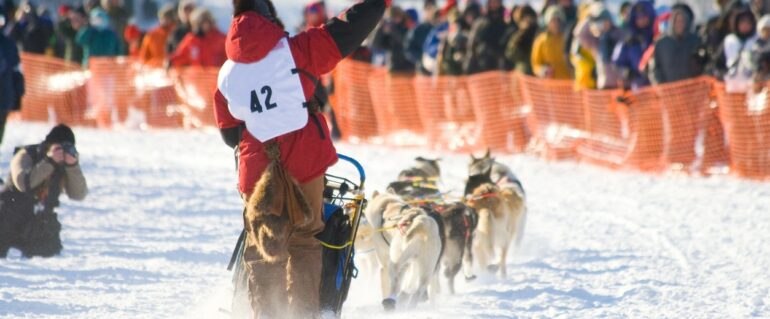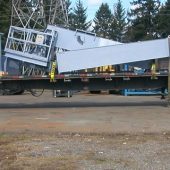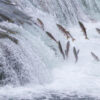2023 Iditarod Overview
The Iditarod Trail Sled Dog Race is one of Alaska’s most popular winter events. Commonly referred to as The Iditarod or The Last Great Race, the long-distance sled dog race takes place on March 3rd every year, starting from Anchorage and ending at Nome. Each team has a dog sled driver, commonly known as a musher, and 12-14 sled dogs that must cover the trail in eight to 15 days. Participants often race in blizzards with wind chills that can be as cold as -100 degrees Fahrenheit. It is seen by many Alaskans as a hallmark occasion and is the premier dogsled racing event in the world.
History
The first Iditarod event started on March 3, 1973, but the trail and practice of using sled dogs have a history that dates back several decades to the beginning of the official race. The trail covers 1,000 miles of rough terrain for contestants, established by government employees in 1908. It was initially used to deliver mail to remote areas of Alaska in an era before airplanes and vehicles were commonplace.
Dog mushing became popularized thanks to the 1925 serum run to Nome. A diphtheria epidemic endangered the lives of Nome’s residents, and sled dogs were the most reliable way to transport medicine from Anchorage to Nome.
The following decades saw the introduction of snowmobiles to Alaska, which gradually phased out sled dogs as the primary form of ground transportation. However, many Alaskans wanted to preserve the historical mail route and sled dog culture. To commemorate Alaska’s centennial year in 1967, the chairwoman of Wasilla-Knik Centennial, Dorothy Page, helped organize a short race on the Iditarod trail. The race’s success led to another event in 1969, which led to the development of today’s annual Iditarod race.
During the early 1970s, an Alaskan resident named Joe Redington Sr. sought to preserve the heritage of sled dogs in Alaska. Redington partnered with two schoolteachers, Gleo Huyck and Tom Johnson, to plan the first official race in October 1972.
How it Works
The Iditarod begins with mushers and their sled dog teams gathering at the starting point in downtown Anchorage. Each team leaves in two-minute intervals and travels about 70 miles north to the town of Willow, where the race’s official start occurs. The mushers and dogs will spend the rest of the day preparing for the following morning’s race.
From Willow, there are two routes for each team to take. The northern route is used in even years, while the southern one is used in odd-numbered years. While each route has the same starting point, they diverge for around 444 miles. Both paths converge about 441 miles away from the ending point in Nome. The trails were designed to minimize the race’s impact on the towns along the way.
The northern route has 26 checkpoints, while the southern route has 27. During their stay at each checkpoint, mushers can rest, eat, communicate with loved ones, and monitor their dogs’ health. Veterinarians are stationed throughout the trail to ensure each dog is in good condition and provide medical care. There are three mandatory stops, one for 24 hours and two lasting eight hours.
Upon completing the race, contestants will split the prize money, with the first-place finisher receiving the largest prize and each finisher afterward gradually receiving less. Every participant is guaranteed a prize of about 1,049 dollars. In addition, there are special awards given out to participants who meet specific criteria.
2023 Schedule
| Event | Date/Time | Location |
| Mushers Banquet Gala | March 2, 2023, @6:00pm | Dena’ina Center |
| Ceremonial Start | March 4, 2023, @10:00am | Downtown Anchorage |
| Official Start | March 5, 2023, @2:00pm | Willow |
| Finishers Banquet | March 19, 2023 | Nome |
Interesting Iditarod Facts
- Teams have an average of 14 dogs, meaning that over 1,000 dogs leave Anchorage during each race.
- The highest number of finishers was 78 in 2008.
- The current record holder for the fastest finishing time is Mitch Seavey, who finished in 8 days, 3 hours, 40 minutes, and 13 seconds on March 14th, 2017.
- Mitch Seavey’s son, Dallas Seavey, and Rick Swenson hold the record for the highest number of wins, with five.
- The closest finish was in 1978 when Dick Mackey finished one second ahead of runner-up Rick Swenson. Mackey’s lead dog clinched first place by getting its nose across the finish line.
The Iditarod is a mainstay of Alaskan culture where mushers and their dogs utilize rigorous training and shared bonds to overcome harsh conditions. The drama and action behind the Iditarod draw in Alaskans and visitors worldwide to tune in or visit portions of the trail to get a glimpse of The Last Great Race.










